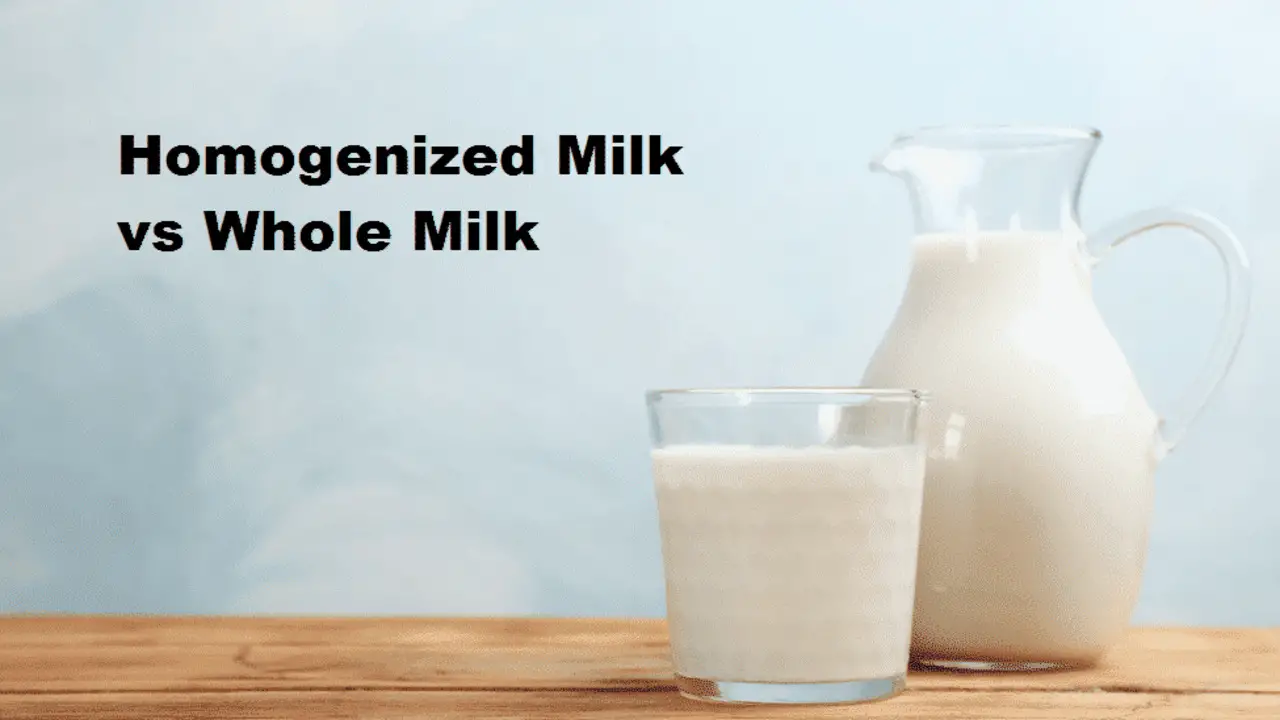When to milk, there are a variety of options to choose from. The choices can be overwhelming, from skim to whole and plant-based alternatives.
The dairy industry commonly debates homogenized milk versus whole milk. While both options are widely available and popular amongst consumers, they offer different benefits and drawbacks. Homogenized milk is processed to ensure that the fat is evenly distributed. While whole milk contains all its natural fat.
Both varieties are widely available in supermarkets, but which one is the best choice for you? In this blog post, we will explore the key differences between Homogenized milk vs whole milk. Whether you’re a fitness enthusiast, a health-conscious individual or a milk lover, we’ve got you covered.

Homogenized Milk Vs Whole Milk: Understanding The Differences

Knowing the difference between homogenized milk and whole milk is important for a number of reasons. Homogenized milk is a type of milk that has been mechanically processed to break down fat molecules. Making them smaller and more evenly distributed throughout the milk.
This process prevents the cream from separating from the milk, which is why homogenized milk has a more consistent texture and appearance. On the other hand, whole milk contains a higher percentage of fat, which gives it a richer and creamier taste. Understanding Homogenized milk vs whole milk can help consumers make informed decisions about their dietary choices.
What Is Homogenized Milk?

Homogenized milk is a type of milk that undergoes a process. Of treatment that ensures that the fat particles in it are evenly dispersed throughout the liquid. Passing the milk through a high-pressure system that breaks down achieves this process. The fat molecules are into smaller particles and distributed evenly throughout the milk.
This ensures the milk remains smooth and consistent in texture, with no visible separation of the cream on top. One of the main benefits of homogenized milk is that it has a longer shelf life than non-homogenized milk.
This is because the fat particles in homogenized milk are much smaller and more evenly distributed, which makes it less likely to spoil quickly. Homogenized milk is also easier to digest for some people, as the smaller fat particles make it easier for the body to break down and absorb.
What Is Whole Milk?

Cows produce whole milk, which is a type of dairy product. Whole milk contains all the natural fat content present in the milk in its original state. They do not process the milk to remove any fat content, which sets it apart from other types of milk, such as skimmed and 2% milk.
Whole milk has a creamy texture and a rich taste due to its fat content. This milk is an excellent source of nutrients such as calcium, protein, and vitamin D. Calcium is essential for developing strong bones. In contrast, protein is essential for building and repairing muscles.
Vitamin D is crucial for the absorption of calcium in the body. Whole milk is an ideal choice for people looking to gain weight or want to maintain weight, as it contains more calories than other types of milk.
The Homogenization Process
The Homogenization Process is a crucial technique handy in various industries such as food, pharmaceuticals, and cosmetics. It involves the reduction of particle size to create a uniform and consistent mixture. Knowing the importance of this process is essential, especially in the food industry, where homogenization is necessary to produce a stable and uniform product.
The process prevents cream separation in milk and allows for a smooth texture in products like ice cream and yoghurt. In the pharmaceutical and cosmetic industries, homogenization ensures that the product is evenly distributed, providing consistent results for the consumer. Additionally, understanding the Homogenization Process can aid in reducing waste, improving efficiency, and increasing product yield.
Homogenization Benefits
Homogenization is a process that has many benefits in several fields. In the food industry, homogenization helps to break down the fat molecules in milk, creating a smoother and more consistent texture. This process also helps to extend the shelf life of milk and other dairy products.
In the pharmaceutical industry, homogenization creates a uniform and consistent drug formulations, ensuring that each dose contains the same active ingredient. This helps to improve the effectiveness of the medication and reduce the risk of inconsistent dosing.
Materials scientists use homogenization to create alloys with consistent compositions. Leading to improved mechanical properties and durability. Additionally, environmental science can use homogenization to create uniform samples for testing and analysis.
Nutritional Comparison Homogenized Milk Vs Whole Milk

When choosing between homogenized milk and whole milk, it is important to consider the nutritional differences. Homogenized milk, also known as “regular” milk, undergoes a process that breaks down the fat to create a uniform texture throughout the milk.
On the other hand, whole milk lacks homogenization and includes all of the natural fat. Homogenized and whole milk contains approximately 150 calories per cup in terms of calorie content. However, whole milk contains more fat and cholesterol, while homogenized milk has a slightly higher carbohydrate content.
Regarding vitamins and minerals, both types of milk contain calcium, vitamin D, and vitamin B12. However, whole milk contains more vitamin A than homogenized milk. It is important to note that both homogenized and whole milk can be part of a healthy diet in moderation.
Flavor And Texture Homogenized Milk Vs Whole Milk

The market offers two main varieties of milk – homogenized milk and whole milk. Both derive from the same source, but their flavor and texture are key differences. Homogenized milk is milk that has undergone a process of mechanical homogenization, which breaks down the fat molecules and distributes them evenly throughout the milk.
The even distribution of fat throughout the milk results in a smoother texture and a more consistent flavor. Those who enjoy a more uniform flavor and texture in their milk often prefer homogenized milk.
On the other hand, whole milk is milk that has not undergone this process of homogenization, and as a result, the fat molecules in the milk remain intact and form a cream layer on top. This gives whole milk a richer, creamier flavor and a slightly thicker texture.
Digestibility And Lactose Intolerance
The digestibility of milk is a topic of interest for many people, especially those with lactose intolerance. Lactose intolerance is a condition where the body is unable to digest lactose, a sugar found in milk and other dairy products. One common solution for lactose intolerance is switching to lactose-free milk.
However, another option is to switch from whole milk to homogenized milk. Homogenized milk undergoes a process of mechanical homogenization that breaks down the fat globules in the milk, resulting in a smoother texture and better digestibility.
Whole milk, on the other hand, has a higher fat content and larger fat globules that can be more difficult for the body to digest. While homogenized milk may be easier to digest for those with lactose intolerance, it is important to note that it still contains lactose.
Shelf Life And Storage
Regarding milk, shelf life and storage are important factors to consider. Homogenized and whole milk have different properties affecting their shelf life and storage requirements. The processor homogenizes milk to emulsify the fat particles, resulting in a smoother texture and longer shelf life.
If you store it below 40°F, it can last up to two weeks in the refrigerator. On the other hand, whole milk contains natural cream that rises to the top, making it prone to spoil faster. You must keep it in an airtight container below 40°F as it has a shorter shelf life of about five to seven days. Regarding storage, it is important to keep milk away from heat and light sources, as they can accelerate spoilage.
Usage In Culinary Applications
Knowing the usage of ingredients in culinary applications is crucial for any aspiring chef. First and foremost, understanding how ingredients are handy in cooking can greatly improve the quality and taste of meals. Knowing the right amount of each ingredient and how to prepare them.
Properly cooking the dish will ensure it is cooked to perfection and satisfies the palate of those who consume it. Additionally, knowing the usage of ingredients can help chefs create innovative and unique dishes that stand out from the rest. It allows them to experiment with different ingredients and techniques to create new and exciting flavors that elevate their cuisine to the next level.
Not only does this help chefs showcase their creativity and skills, but it also helps them stay ahead of the competition and attract more customers. Moreover, understanding the usage of ingredients can also have health benefits.
1.Cooking And Baking
Cooking and baking are two activities that people have enjoyed for centuries. Not all milk is created equal as an ingredient. There are two popular types of milk: homogenized milk and whole milk. Homogenized milk is a type of milk that has undergone a process of emulsification, which reduces the size of the fat globules and makes them evenly distributed throughout the milk.
On the other hand, whole milk has not undergone any fat removal or reduction process and thus contains all the fat. Regarding cooking and baking, the choice between homogenized milk and whole milk depends on the desired outcome. Homogenized milk is preferred for recipes that require a smooth and consistent texture, such as custards, puddings, and sauces.
2.Frothing For Coffee
For coffee lovers, there is nothing quite like perfectly frothed milk to complement their favorite cup. When it comes to frothing, the debate between homogenized and whole milk is ongoing. Homogenized milk has a uniform consistency and creaminess.
People value whole milk for its rich flavor and higher fat content. The choice between the two largely depends on personal preference and the type of coffee being prepared. People generally prefer to use homogenized milk for espresso-based drinks.
Producing a smoother and more consistent texture. On the other hand, for drip coffee or pour-over methods, whole milk may be the better choice as it complements the bold flavors of the coffee and adds depth to the drink. Regardless of the type of milk used, the key to perfect frothing is achieving the right temperature and texture.
Health Considerations
When it comes to choosing between homogenized milk and whole milk, there are several health considerations to take into account. Homogenized milk is processed through a mechanical process that breaks down the fat globules, resulting in a smoother, more uniform texture. On the other hand, whole milk is simply milk that has not undergone this process and contains its natural fat content.
From a calorie standpoint, whole milk typically has more calories than homogenized milk due to its higher fat content. However, some studies suggest that consuming full-fat dairy products may have health benefits, such as improved heart health and a reduced risk of type 2 diabetes. Moreover, lactose intolerant people may prefer homogenized milk as the process of homogenization breaks down the lactose, making it easier to digest.
1.Heart Health
Heart health is a topic of great concern in today’s society. Many people are looking for ways to improve their cardiovascular health, and one area of interest is the impact of different types of milk on the heart. Homogenized and whole milk are two types of milk that are often compared regarding their effects on heart health. Breaking down the fat into smaller particles in homogenized milk makes it easier to digest.
On the other hand, whole milk has not been processed this way and still contains its natural fat content. Studies have shown that consuming whole milk may positively impact heart health. Researchers have found that the natural fats in whole milk help reduce the risk of heart disease. By lowering LDL cholesterol levels, also known as “bad” cholesterol.
2.Weight Management
Weight management is a crucial aspect of a healthy lifestyle. The type of milk consumed can affect weight as a key factor. People often compare homogenized and whole milk. Their impact on weight management. Homogenized milk is a type of milk that has been treated to prevent the cream from separating and forming a layer on top.
This process results in a more uniform distribution of fat throughout the milk. On the other hand, whole milk has not undergone any treatment and thus contains the natural cream layer. People often view whole milk as the less healthy option regarding. Weight management due to its higher fat content. However, recent studies suggest that the fat content in whole milk may not significantly impact weight gain.
3.Dairy Allergies
Dairy allergies are becoming increasingly common today, with many people experiencing adverse reactions to various dairy products. One of the most debated topics regarding dairy allergies is whether homogenized milk or whole milk is better for those sensitive to dairy. Milk companies mechanically process homogenized milk to break up the fat globules.
The fat globules and evenly distributed throughout the milk. On the other hand, whole milk is simply milk that has not been processed. This way, and contains a higher fat percentage. The issue with dairy allergies is that they are caused by a protein found in milk, not the fat content. Therefore, the debate between homogenized and whole milk is irrelevant regarding dairy allergies.
Conclusion
The comparison between homogenized and whole milk reveals distinct differences catering to various preferences and dietary needs. Homogenized milk undergoes a mechanical process that ensures uniform fat distribution, resulting in a consistent texture and a slightly lower fat content.
On the other hand, whole milk remains natural, retaining its higher fat content and creamy texture, along with all the essential vitamins and minerals. Whether it’s homogenized milk or whole milk, both have unique qualities, benefits, and taste profiles. By understanding the differences between homogenized milk vs whole milk consumers can make an informed decision that aligns with their needs and values.
FAQ
1.What Is The Main Difference Between Homogenized Milk And Whole Milk?
Ans: The main difference lies in their fat content and texture. Homogenized milk has undergone a process to break down fat globules, resulting in a uniform texture and lower fat content. Still, whole milk is in its natural state with higher fat content and a creamier texture.
2.Which Type Of Milk Has A Longer Shelf Life?
Ans: Homogenized milk generally has a longer shelf life than whole milk due to its uniform fat distribution, which helps delay spoilage. It also has a smoother texture and is less likely to separate when cooking or baking.
3.Does Homogenization Affect The Taste Of Milk?
Ans: Some people argue that homogenization alters the taste of milk, making it lighter and less creamy than whole milk’s richer flavour. However, others prefer homogenized milk because it has a consistent texture and does not separate into cream and milk. Additionally, homogenized milk has a longer shelf life than whole milk and is less likely to spoil quickly.
4.Can Individuals With Lactose Intolerance Consume Either Type Of Milk?
Ans: Both homogenized milk and whole milk contain lactose, the natural sugar in milk. Some people with lactose intolerance may find that whole milk is easier to digest due to the presence of cream. However, homogenized milk may be a better option for individuals who are not lactose intolerant as it is typically more readily available and has a longer shelf life due to the homogenization process.
5.Which Type Of Milk Is Preferred For Frothing In Coffee Preparation?
Ans: Baristas often prefer whole milk for frothing as its higher fat content produces a creamier foam. However, some have also had success with homogenized milk for this purpose. Regarding taste, homogenized milk may have a slightly different flavor profile than whole milk due to the homogenization process.